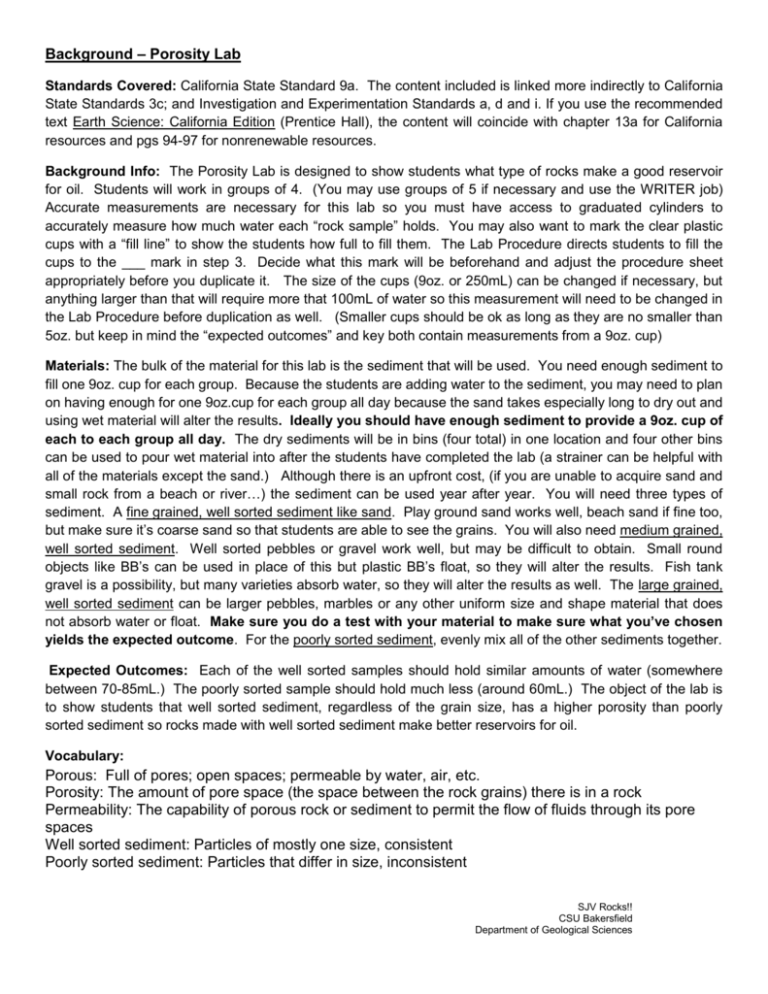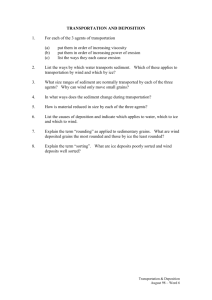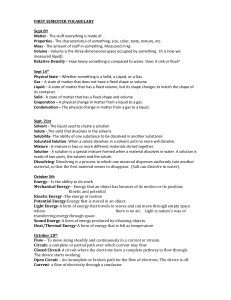Porosity Lab Background and Lesson Plan
advertisement

Background – Porosity Lab Standards Covered: California State Standard 9a. The content included is linked more indirectly to California State Standards 3c; and Investigation and Experimentation Standards a, d and i. If you use the recommended text Earth Science: California Edition (Prentice Hall), the content will coincide with chapter 13a for California resources and pgs 94-97 for nonrenewable resources. Background Info: The Porosity Lab is designed to show students what type of rocks make a good reservoir for oil. Students will work in groups of 4. (You may use groups of 5 if necessary and use the WRITER job) Accurate measurements are necessary for this lab so you must have access to graduated cylinders to accurately measure how much water each “rock sample” holds. You may also want to mark the clear plastic cups with a “fill line” to show the students how full to fill them. The Lab Procedure directs students to fill the cups to the ___ mark in step 3. Decide what this mark will be beforehand and adjust the procedure sheet appropriately before you duplicate it. The size of the cups (9oz. or 250mL) can be changed if necessary, but anything larger than that will require more that 100mL of water so this measurement will need to be changed in the Lab Procedure before duplication as well. (Smaller cups should be ok as long as they are no smaller than 5oz. but keep in mind the “expected outcomes” and key both contain measurements from a 9oz. cup) Materials: The bulk of the material for this lab is the sediment that will be used. You need enough sediment to fill one 9oz. cup for each group. Because the students are adding water to the sediment, you may need to plan on having enough for one 9oz.cup for each group all day because the sand takes especially long to dry out and using wet material will alter the results. Ideally you should have enough sediment to provide a 9oz. cup of each to each group all day. The dry sediments will be in bins (four total) in one location and four other bins can be used to pour wet material into after the students have completed the lab (a strainer can be helpful with all of the materials except the sand.) Although there is an upfront cost, (if you are unable to acquire sand and small rock from a beach or river…) the sediment can be used year after year. You will need three types of sediment. A fine grained, well sorted sediment like sand. Play ground sand works well, beach sand if fine too, but make sure it’s coarse sand so that students are able to see the grains. You will also need medium grained, well sorted sediment. Well sorted pebbles or gravel work well, but may be difficult to obtain. Small round objects like BB’s can be used in place of this but plastic BB’s float, so they will alter the results. Fish tank gravel is a possibility, but many varieties absorb water, so they will alter the results as well. The large grained, well sorted sediment can be larger pebbles, marbles or any other uniform size and shape material that does not absorb water or float. Make sure you do a test with your material to make sure what you’ve chosen yields the expected outcome. For the poorly sorted sediment, evenly mix all of the other sediments together. Expected Outcomes: Each of the well sorted samples should hold similar amounts of water (somewhere between 70-85mL.) The poorly sorted sample should hold much less (around 60mL.) The object of the lab is to show students that well sorted sediment, regardless of the grain size, has a higher porosity than poorly sorted sediment so rocks made with well sorted sediment make better reservoirs for oil. Vocabulary: Porous: Full of pores; open spaces; permeable by water, air, etc. Porosity: The amount of pore space (the space between the rock grains) there is in a rock Permeability: The capability of porous rock or sediment to permit the flow of fluids through its pore spaces Well sorted sediment: Particles of mostly one size, consistent Poorly sorted sediment: Particles that differ in size, inconsistent SJV Rocks!! CSU Bakersfield Department of Geological Sciences







